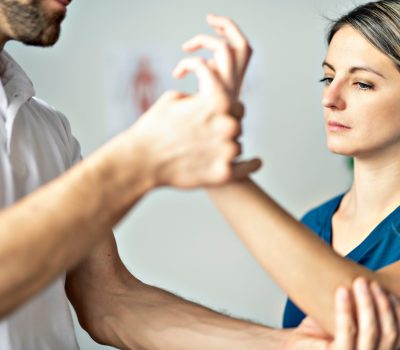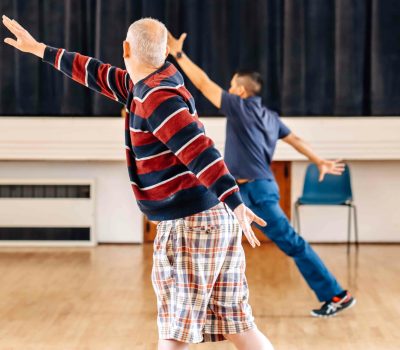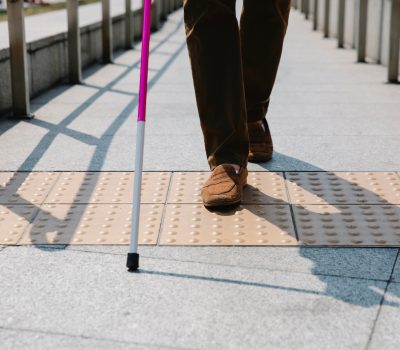What is foot drop:
Foot drop happens when, for reasons described below, it becomes difficult to lift your toes up. This can cause your foot to drag or catch while walking, making mobility difficult or even causing falls.
What causes foot drop:
Our muscles move thanks to two things: 1/ receiving the message from the brain to move the muscle, and 2/ the muscle itself activating strongly enough to move your body. When either of those steps doesn’t happen for the muscle which lifts your toes up, it makes your foot “drop”. This can cause you to catch your toes on obstacles, or feel like you really have to lift your leg up to fully clear the floor.
Some neurological conditions cause a problem for the message from the brain to “send” properly (for example, after a stroke), whereas some neurological conditions affect the nerves which carry the message to the foot muscles (for example, in MS).
In both cases, it will become harder to move your foot, which means you are likely to stop walking as much, or find other ways to walk without using your foot muscle. In turn, this will cause your muscle strength to decrease, so moving will become even more difficult and it can create a bit of a vicious cycle.
How can I improve my Foot Drop?
Exercising: how does it help?
Neuroplasticity:
Have a look at the article “Living with a Neurological Condition” for the full details. The gist of neuroplasticity is this: it is possible to learn/relearn things through intense and frequent repetitions of the movement you wish to get back. This means that if you have a condition which affects the “sending the message” part of movement (ie: stroke, Parkinson’s Disease, Traumatic Brain Injury), different parts of the brain can learn to ask your muscles to lift your foot. It is worth noting this isn’t always possible, and there are orthotics/splints available to assist you with keeping your toes up when walking, without relying on your muscles.
Strengthening:
There are two reasons we know of to explain why exercises help you get stronger. Firstly, when you exercise to a point where you start fatiguing but “power through” a little, your muscle cells will start to create more muscle mass. Secondly, the more you activate a muscle, the more efficient it becomes at using all its available strength. Think of it like an energy saving light bulb: when you first turn the light on, it doesn’t shine very bright. But, when you give it a minute, more of the light bulb starts to shine, and it shines brighter. In the same way, when you first move, some of your muscle cells don’t kick in, but the more you do it, the more efficient your muscle gets.
Moving more
The more you exercise, the easier it will be to move. This will encourage you to stay active, in turn helping you progress even more!
Exercising: what exercises should I do?
Walking:
There are two reasons we know of to explain why exercises help you get stronger. Firstly, when you exercise to a point where you start fatiguing but “power through” a little, your muscle cells will start to create more muscle mass. Secondly, the more you activate a muscle, the more efficient it becomes at using all its available strength. Think of it like an energy saving light bulb: when you first turn the light on, it doesn’t shine very bright. But, when you give it a minute, more of the light bulb starts to shine, and it shines brighter. In the same way, when you first move, some of your muscle cells don’t kick in, but the more you do it, the more efficient your muscle gets.
Pointing your toes up to the ceiling:
Repeat this several times in a row, several times a day. You can do it standing while you’re waiting for the kettle to boil, or sitting when you’re watching the telly. It will help your muscle stay strong, and keep the nerve connection between your brain and foot strong.
Stretching:
Sitting down, grab a belt or a scarf and pass it under your foot. Pull both ends up to bring your toes up and give the back of your ankle and your calf a stretch (this should also be doable one-handed). Hold that position for 20 seconds, then relax and do it again 2 more times. This will help prevent your foot from getting stiff and being even harder to lift. Do this exercise with your knee straight.
Calf raises:
Practice coming up on your tip-toes. You can try doing this on one foot if two feels too easy.
Balance exercises:
Staying stable can be an issue when you have foot-drop, so practising different stances to challenge your balance can be helpful. Start easy with both feet hip-width apart, and progress to having your feet closer together, one in front of the other, or standing on one leg. Always make sure you have somewhere to hold onto and a seat behind you when you train your balance, that way you reduce your risk of falling.
Orthotics/Splints - what are they?
An ankle-foot orthotic (AFO) or splint is a piece of equipment which helps keep your foot in the “toes-up” position.
How do orthoses work?
Orthotics work by essentially “picking up the slack” when your muscles are unable or less able to lift your foot up from the floor. There are many different mechanisms in which orthotics do this, some are described below. Finding the right one for you can be a challenge, have a look at the equipment reviews section of our website to find out more about specific uses and designs.
How do I choose an orthotic?
This should be done with a movement specialist (eg: physiotherapist, occupational therapist or orthotist) to help you choose which one is right for you. The model you use will depend on things like which condition you have, how much support your muscles need, and the way that you walk.
What are some of the pros and cons of orthotics?
Pros:
- Enables you to walk better/faster/longer
- Reduces risk of falling
- Allows you to exercise other parts of your body without being limited by foot-drop
- Improves your quality of life by helping you access more things (eg: outdoor activities)
Cons:
- They’re not always comfortable and can require adjustments which take time. If you need to wear an orthotic for prolonged periods of time and it is not properly fitted, it can also cause blisters, bruising or other skin damage.
- Too much support can encourage your muscles to really relax and become weaker on the long term, which makes you dependent on your orthotic
- Cost: there are all sorts of price ranges, but some of the more expensive/advanced models range in the thousands of pounds
- Aesthetics: some models are discreet, but others are bulkier and not everyone likes the robotic-leg look.
Examples of orthotics: have a look at the equipment reviews on our website, they will tell you more about what you need to know about each of those.
This is just a snapshot of the splints available on the market, seeing a specialist physiotherapist will help you decide which is right for you.
Functional Electrical Stimulation (FES):
This is a type of device which, similarly to an orthotic/splint, aims to support the movement of lifting the toes up, though it does so using a very different mechanism. It works by sending an electrical impulse to the muscle via 2 electrodes placed on the skin over the muscle, this will lift the foot up. Read more about the details of FES and a comparison of different models on the equipment reviews part of our website. Because FES relies on the nerves carrying the electrical impulse to the muscle belly, it is not appropriate for people who have something called “peripheral nerve damage” (eg: peripheral neuropathy, Guillain-Barre Syndrome). You will need to find a specialist physiotherapist to assess whether this is right for you.










